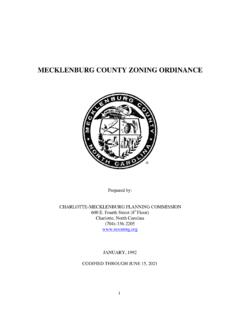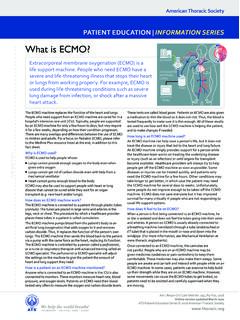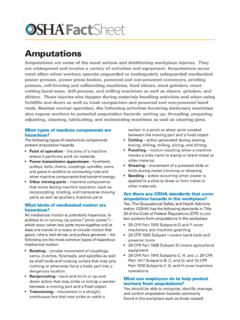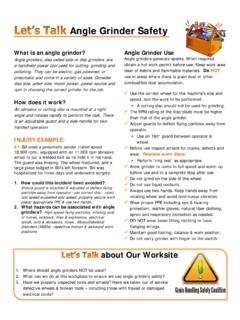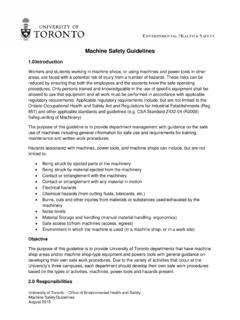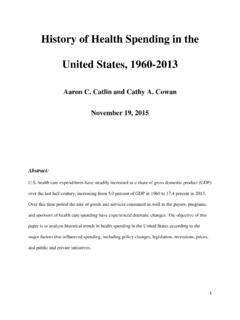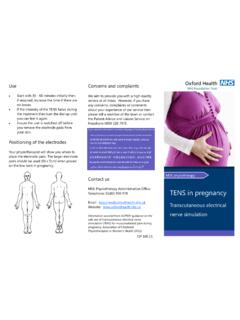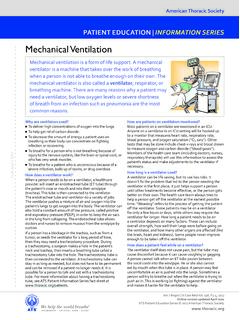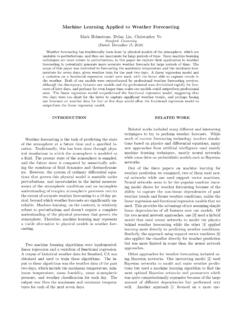Transcription of Vomit and Diarrhea Clean Up - mecknc.gov
1 Prepared: March 2018 1 Cleaning Up Vomit and Diarrhea Events Vomit and Diarrhea Clean Up Vomit and Diarrhea have millions of microorganisms that can cause foodborne disease. To prevent the spread of these microorganisms, all foodservice establishments must have a Clean -up procedure in place. Food workers should not Clean up Vomit or Diarrhea . ASSEMBLE A Clean -UP KIT You can buy a kit from a supplier or assemble your own. Clean -up kits should contain personal protective equipment and cleaning supplies. Personal Protective Equipmenta 2 pairs of single-use gloves 1 face mask 1 pair of goggles 1 single-use gown with sleeves 1 single-use hair cover 1 pair of shoe coversCleaning Supplies 1 sealable, plastic bag with twist tie 1 scoop/scraper 1 roll of paper towels Absorbent powder/solidifier (such as kitty litter) 1-quart bottle of disinfectantba Personal Protective Equipment.
2 At a minimum, your kit should have single-use gloves and a pair of goggles. b Making Your Own Disinfectants. If you use concentrated bleach (shown as on the label) to make your owndisinfectant, add 3/4 cups of bleach to 1 gallon of water. If you use regular bleach, (shown as on the label), add 1 cup of bleach to 1gallon of water. You can also use commercially prepared disinfectants. The EnvironmentalProtection Agency has a list of other commercial disinfectants that you can Clean UP BEGINS Ask everyone to leave the area where the event occurred. This includes customers andworkers. Block off this area to keep out anyone who is not cleaning up the area. Put on personal protective equipment. At the very least, anyone cleaning up Vomit ordiarrhea must wear single-use gloves and : March 2018 2 Cleaning Up Vomit and Diarrhea Events CLEANING UP SURFACES Many types of surfaces can become contaminated when someone throws up or experiences Diarrhea in your establishment.
3 It is important that you use the correct Clean up procedure for the surface(s) that are contaminated. Three types of surfaces are common in foodservice establishments: Hard surfaces (floors, tables, utensils) Soft surfaces that cannot be laundered (carpet and upholstered furniture) Soft surfaces that can be laundered (linens, towels, and clothing)HARD SURFACES STEP 1: Cover Cover the Vomit or Diarrhea with paper towels or an absorbent powder (such as kittylitter) to soak up 2: Remove Remove the paper towels or hardened powder with a scoop/scraper and immediatelyplace them in a plastic 3: Wash Prepare a solution of soapy water. Wash all surfaces contaminated with Vomit or Diarrhea with this solution. This includesall nearby surfaces possibly splashed by Vomit or Diarrhea , such as chair legs, tables,walls, shelves, or counters.
4 Wash as wide of an area surrounding the Vomit or diarrheaas is possible. Rinse the soapy water from all surfaces with Clean 4: Disinfect Using paper towels or a mop with a washable mop head, saturate all washed surfaceswith a disinfectant. The disinfectant can be commercially prepared or one prepared in-house (see Assemble a Clean -Up Kit ). If using a disinfectant that is prepared in house, let it sit for 10 minutes. If using acommercially prepared disinfectant, follow the manufacturer instructions. Rinse all food-contact surfaces with Clean water after they have been surfaces do not need to be : March 2018 3 Cleaning Up Vomit and Diarrhea Events CARPET AND UPHOLSTERED FURNITURE STEP 1: Cover Cover the Vomit or Diarrhea with paper towels or an absorbent powder (such as kittylitter) to soak up 2: Remove Scoop up the paper towels or hardened powder with the scoop/scraper and place in asealable plastic bag.
5 Never vacuum after this 3: Wash Prepare a solution of soapy water. Using soapy water, wash all carpet and upholstered surfaces contaminated with vomitor Diarrhea . Wash as wide of an area as is possible. Rinse the soapy water from all 4: Disinfect Steam Clean the area for 5 minutes at a temperature of 170 F ( C). (Not all steamcleaners can reach a temperature for 170 F ( C), so check the manufacturingspecifications.) Upholstered furniture that is soiled with Vomit or Diarrhea can also be disinfected with ableach solution (described in Assemble a Clean -Up Kit ), however, the bleach willdiscolor the , TOWELS, AND CLOTHING STEP 1: Contain Carefully place all contaminated items that can be washed in a washing machine in aplastic bag then seal the plastic 2: Wash machine wash soiled items in a washing machine using hot water and laundrydetergent.
6 For loads of all white items, add 5-25 tablespoons of bleach per gallon of 3: Dry Dry the just-washed items in a dryer on the high-heat : March 20184 Cleaning Up Vomit and Diarrhea Events AFTER Clean UP STEP 1: Remove Remove all personal protective equipment and place in the plastic bag. Do not touchany of the surfaces that were just cleaned as they can be re-contaminated. All personalprotective equipment must be taken off before leaving the area that has just beencleaned. Place all used cleaning supplies, such as paper towels and disposable mop heads, in theplastic bag. Seal the bag with a twist tie. Throw away all uncovered food near the Vomit or Diarrhea event as well as any foodhandled by the person who was sick.
7 Remove all waste from the facility immediately following local, state, or federal 2: Clean mops and scoops Wash and disinfect mop handles and other reusable cleaning supplies, such asscoops/scrapers, using the same steps as used for hard 3: Wash hands Wash hands thoroughly before performing any other WORKERS ON Clean -UP PROCEDURES Identify who will be in charge of cleaning up after Vomit and Diarrhea events. Train selected workers in how to use personal protective equipment; wash and disinfectsurfaces; and dispose of Vomit and Diarrhea . Training should take place when:- the Vomit and Diarrhea Clean -up procedures are first written and put in place;- new workers are hired; and- Vomit and Diarrhea procedures are This work was funded through a grant from the Department of Agriculture, National Institute of Food and Agriculture, Agriculture and Food Research Initiative, Building Capacity to Control Viral Foodborne Disease: A Translational, Multidisciplinary Approach, Grant No.
8 2011-68003-30395. Provided by: [Instructor name] Content Analysis of Vomit and Diarrhea Cleanup ProceduresTo Prevent Norovirus Infections in Retail and FoodService OperationsMORGAN G. CHAO,1 ANNE-JULIE DUB E,1 CORTNEY M. LEONE,1 CHRISTINA M. MOORE,2 ANDANGELA M. FRASER1*1 Clemson University, Clemson, South Carolina 29634; and2 North Carolina State University, Raleigh, North Carolina 27695, USAMS 16-196: Received 9 May 2016/Accepted 22 July 2016 ABSTRACTH uman noroviruses are the leading cause of foodborne disease in the United States, sickening 19 to 21 million Americanseach year. Vomit and Diarrhea are both highly concentrated sources of norovirus particles. For this reason, establishingappropriate cleanup procedures for these two substances is critical.
9 Food service establishments in states that have adopted the2009 or 2013 Food and Drug Administration Food Code are required to have a program detailing specific cleanupprocedures. The aim of our study was to determine the alignment of existing Vomit and Diarrhea cleanup procedures with the 11elements recommended in Annex 3 of the 2011 Supplement to the 2009 Food Code and to determine their readability and clarityof presentation. In July 2015, we located Vomit and Diarrhea cleanup procedures by asking Norovirus Collaborative for Outreach,Research, and Education stakeholders for procedures used by their constituency groups and by conducting a Google AdvancedSearch of the World Wide Web. We performed content analysis to determine alignment with the recommendations in Annex and clarity of presentation were also assessed.
10 A total of 38 artifacts were analyzed. The mean alignment score of 11 points; the mean clarity score was of 17 points. Only nine artifacts were classified as high clarity, highalignment. Vomit and Diarrhea cleanup procedures should align with Annex 3 in the Food Code and should, as well, be clearlypresented; yet, none of the artifacts completely met both conditions. To reduce the spread of norovirus infections in food serviceestablishments, editable guidelines are needed that are aligned with Annex 3 and are clearly written, into which authors couldinsert their facility-specific words: Cleaning; Food Code; Food Safety; Gastroenteritis; RestaurantsHuman noroviruses are the leading cause of acutegastroenteritis and foodborne disease in the United States(10).









